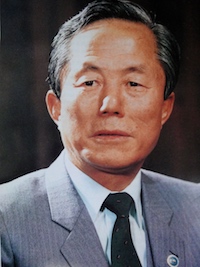Black Belt Theory
Tae Kwon Do Theory 1st Kup Black Belt Questions
- How many moves in Choong-Moo? - 30
- Meaning of Choong-Moo? -Â Choong-Moo was the name given to the great Admiral Yi Sun Sin of the Yi Dynasty. He was reputed to have invented the first armoured battleship (Kobukson) in 1592, which was the precursor of the present day submarine. The reason that this pattern ends with a left hand attack is to symbolize his regrettable death, having no chance to show his unrestrained potentiality checked by the forced reservation of his loyalty to the king.
- What is the purpose of the 360 jump and spin into Knifehand guarding block in Choong-Moo?-Â To avoid a sweep or low attack and to disorientate the opponent.
- Demo & what is the Korean for X-knifehand checking block? -Â Kyocha Sonkal Momchau Makgi
- What is the Korean for upward twin palm block? - Ollyo Sang Sonbadak Makgi
- What is the Korean for flying side kick? -Â Twimyo Yop Chagi
- What is the Korean for sliding & explain it? -Â Mikulgi - It is an effective technique for covering a long distance in one smooth motion.
- Which 3 patterns have release moves. Demo & explain the difference between them? -Â Do-san, Joong-Gun and Hwa-Rang.
- Name 10 different blocks. Both in Korean & English? -Â Najunde Bakat Palmok makgi, Kaunde An palmok makgi, Najunde Sonkal makgi, Chookyo makgi, Sang Palmok makgi, Sonkal Daebi makgi, Hechyo makgi, Dollymio makgi, Golcho makgi, Sang Sonkal makgi, Doo Palmok makgi, Digutcha makgi, Noolyo makgi, Sonkal Dung makgi, Kyocha Chookyo makgi, Kyocha Noollo makgi, miro makgi, San makgi, Ollyo Sang Sonbabak makgi and Kyocha Sonkal Momchau makgi.
- Name 8 different kicks. Both in Korean & English? -Â Apcha busigi (front snap kick), Yop chajirugi (side piercing kick), Dollyo chagi (turning kick), Dwit chajirugi (back piercing kick), Bandae Dollyo chagi (reverse turning kick), Naeryo chagi (downward or axe kick), Noollo chagi (pressing kick), Yonsok chagi (consecutive kick), Bituro chagi (twisting kick), Twimyo Yop chagi (flying side kick).
- Name 8 different stances. Both in Korean & English? - Gunnon (Walking), Annun (Sitting), Niunja(L stance), Narani (Parrallel), Charyot (Attention), Gojong (fixed), Moa (closed), Goburyo (bending), Kyocha ( “X†), Nachuo (Low), Dwitbal (rear foot), Soojik (vertical), Sogi (Stance).
- Name 8 different hand parts. Both in Korean & English? -Â Fore fist (Ap Joomuk), Back fist (Dung Joomuk), Side fist (Yop Joomuk), Knifehand (Sonkal), Reverse Knifehand (Sonkal Dung), Finger tips (Sonkut), Arc Hand (Bandal Son), Elbow (Palkup), Palm (Sonbadak), Open fist/palm heel (Pyun Joomuk)
- Name 5 different foot parts. Both in Korean & English? -Â Ball of the foot (Apkumchi), Foot sword (Balkal), Instep (Baldung), Back Heel (Dwichook), Toes (Balkut), Back sole (Dwitkumchi), Reverse Foot sword (Balkal Dung) Knee (Moorup).
- What is the Korean for Inward Reverse Knifehand strike? -Â Anaero Ap Sonkal Dung Taerigi
- What is the Korean for Head? -Â Mori
- Name the 4 parts of your forearm. Both in English and Korean? -Â Bakat (outer) An (inner) Dung (back) Mit Palmok (forearm belly)
- Why do we perform patterns? -Â To practice both offensive & defensive techniques against imaginary opponent, or opponents. To build strength, speed, balance and timing with your body.
- Why do we learn the meanings of patterns? -Â To gain inspiration and remember the history of those who came before us.
- What is Twisting kick in Korean & what part of the foot is used. Also what section for what height kick? -Â Bituro Chagi - Ball of the foot (Apkumchi). Low kick to the front, Middle kick to the 45 degree line and High kick over your shoulder to the side & behind you.
Further Example Black Belt Grading Questions
- Name 5 patterns containing backfist.
- Name 3 types of fingertip thrust.
- Name 3 patterns containing releases.
- Why do we do 3 step sparring?
- Why do we learn pattern meanings?
- Name 3 patterns where we do a bending stance.
- Give history of Taekwon-Do and PUMA.
- What is the purpose of the jump in Toi-Gye / Yul-Gok?
- What do 38/29 moves signify?
- How would you teach someone to...? (eg do a walking stance)
- Why do we do slow motion moves?
- How does the release in Do-San work?
- PUMA is affiliated to one national body and one international body. What are they?
- What is the difference between one step and three step sparring?
- A beginner asks you why that blue belt is beating a black belt at sparring. What do you say?
- Explain what degrees are.
- Why do we do the power test?
- What attributes would you look for in a student?
- What is the difference between our Taekwon-Do style and the WTF style?
- Who is the team coach for the PUMA?
- Why is PUMA so successful?
- How do individual pattern meanings insipe us?
- Name as many hand and foot parts as you can.
- Name 3 types of elbow strike.
- How have you developed as a person since starting Taekwon-Do?
- What do you like best about Taekwon-Do?
- There are 5 tenets. If you had to come up with a sixth, what would it be?
- Why do we do patterns?
- What is the differnce between a colour belt and a black belt?
- Who is the chairman of the PUMA?
- If entered into a difficult situation what would be your 3 options in order of priority?
- What is the police policy on defending yourself?
- Name 3 uses of fingertip.
- Explain indomitable spirit.
- What is neo-confuscionism?
- Name all the stances you know in Korean.
- What is the use of a walking and sitting stance?
- Give a full interpretation of Taekwon-Do.
- Name 2 vulnerable parts of the mid section of the body.
- What can you offer your instructor / PUMA if you pass your black belt grading?
- Why do we do one step sparring?
- What do the black stripe on a black belt dobok mean?
- Why did you start Taekwon-Do?
- Name all the stances you know in Korean.
- Describe how to do a side kick without moving.


